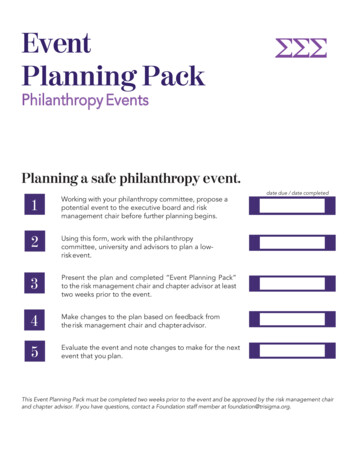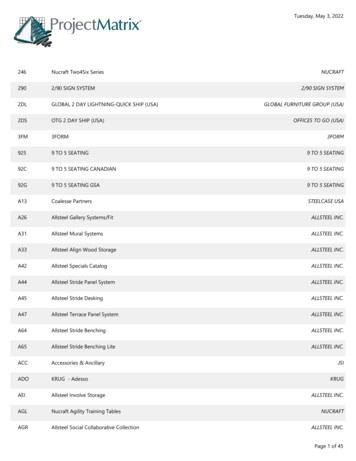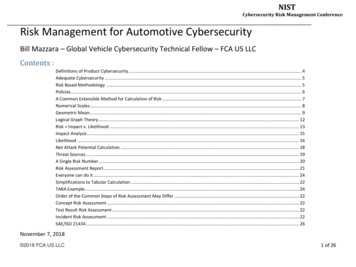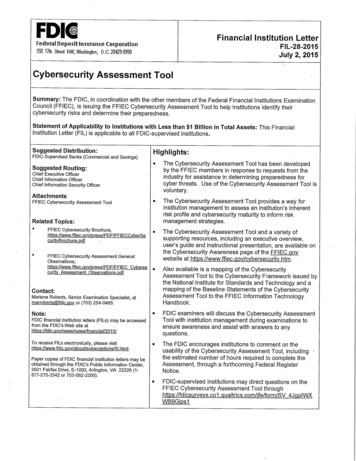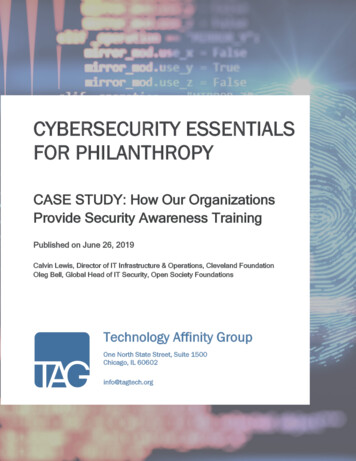
Transcription
CYBERSECURITY ESSENTIALSFOR PHILANTHROPYCASE STUDY: How Our OrganizationsProvide Security Awareness TrainingPublished on June 26, 2019Calvin Lewis, Director of IT Infrastructure & Operations, Cleveland FoundationOleg Bell, Global Head of IT Security, Open Society FoundationsTechnology Affinity GroupOne North State Street, Suite 1500Chicago, IL 60602info@tagtech.org1
2OVERVIEWPRAGMATIC INSIGHT FROM IT LEADERS IN PHILANTHROPYExecutives in philanthropy are increasingly concernedabout cybersecurity. Phishing attacks are weekly, if notdaily, and the stakes of a breach are high. In spite of ourbest attempts as a sector to develop robust practices,21% of respondents to TAG’s 2018 State ofPhilanthropy Tech survey reported experiencing asecurity breach in the past two years. For privateindependent foundations, the breach rate was evenhigher at 24%. No wonder there’s growing concern.Through the CyberSecurity Essentials forPhilanthropy series, we aim to reduce yourorganization’s risk and establish best practicesthroughout the sector.30%Foundations Reporting a Security teSource: 2018 State of Philanthropy Tech Survey, available athttp://www.tagtech.org/philanthropytech2018.The practices and suggestions shared here are those of your peers at philanthropic organizationsthroughout North America. Their on-the-ground knowledge forms the basis for an invaluable set ofbest practices. On behalf of the members and directors of the Technology Affinity Group, we’regrateful for the thought leadership generously shared by this publication’s authors.JAMES R. RUTTChief Information Officer, Dana FoundationPresident, Board of Directors, Technology Affinity GroupCHANTAL E. FORSTERExecutive Director, Technology Affinity GroupCybersecurity Essentials for Philanthropy tagtech.org/cybersecurity
3BRINGING CYBERSECURITY AWARENESS TO PHILANTHROPYThis case study answers the question: What does security look like at mid-sized foundations?With attacks occurring daily in our interconnected digital world, every network enabled deviceis vulnerable. Foundations have the same security concerns as businesses and face the samethreats to sensitive information.Together with peers at foundations similar to yours, we’ve written this case study to provide pragmaticstrategies and real-world tactics based on our everyday experience as IT leaders. In this case study,you’ll find:1. Data on cybersecurity threats to foundations2. How your staff is critical to cybersecurity defense3. Resources and examples on how to approach your cybersecurity trainingLet’s get started.Cybersecurity Essentials for Philanthropy tagtech.org/cybersecurity
4The ChallengeCOMBATTING CYBERCRIMINALSPhilanthropic organizations are increasingly becoming targets of cybercriminals; Open SocietyFoundations and the Cleveland Foundation know this all too well. In our experience, email presents thelargest threat and the biggest risk for our organizations.In 2018 1.6 million email messages traversed the Cleveland Foundation’s email system. Ofthose 1.6 million messages, more than 40 thousand were phishing emails.Technology safeguards provide adequate protection for most phishing attempts, but it is not a failsafe,and unfortunately a small number of phishing emails occasionally evade our defenses and arrive in ourend-user’s inbox. To combat this, both organizations have implemented cybersecurity training andawareness programs to help staff learn how to detect and report phishing attempts.The assumption is that awareness will improve staff’s ability to recognize potentially malicious emailsand reduce their likelihood to fall for such attacks. Although the programs are met with positivefeedback from staff, we are still presented with the challenge of consistently achieving 100%participation of staff in completing the training, reporting all phishing attempts, and continuouslyreducing our click rates.The StrategyBUILDING A HUMAN FIREWALLAs part of the cybersecurity training and awareness programs, Open Society Foundations emphasizescreating an open and positive culture of security threat reporting. By recognizing that no one is perfectand by setting up reasonable thresholds and positive reinforcement mechanisms, IT is able to bothdecrease risk exposure to phish attacks, as well as dramatically increase attack reporting by staff.Positive reinforcement, coupled with education and measurement, has enabled us to build ahuman firewall.We no longer deem staff as a liability, at Open Society Foundations, but rather, we look to them as apartner in detecting cyber-attacks that our technology systems miss. The staff are our “canary in themineshaft” and the most effective early detection and alert system.Cybersecurity Essentials for Philanthropy tagtech.org/cybersecurity
5The ApproachCONTINUOUS TRAININGTraining is key in building our “human firewall.” Both Open Society Foundations and ClevelandFoundation prioritize a wide variety of training and simulation programs.Training Approach at Cleveland FoundationAt the Cleveland Foundation, we assessed various phishing simulation and training service providerson the market, and selected Wombat Security, a division of Proofpoint. Cleveland Foundation choseWombat for three reasons:1. Innovation put them ahead of anything else onthe market.Assessment2. Their approach aligned with the culture of theorganization.3. Their continuous training methodology, whichconsists of assessment (via phish simulations),education (via training modules),Culture ofreinforcement (via library of images, articlesMeasurementEducationAwarenessand posters on security awareness), andmeasurement (via reporting on strengths andweakness) helps to increase learning andcreates a culture of awareness.ReinforcementIn terms of specific products, Cleveland Foundationuses Wombat’s “Anti-Phishing Training Suite”,which combines customizable “Threat Sim PhishingSimulations”, interactive training modules, and significant business intelligence and reporting tools.Cleveland Foundation assigns training every other month and conducts phishing simulationscontinuously throughout the year.Training Approach at Open Society FoundationsIn contrast, Open Society Foundations (OSF) uses both in-house and subscription materials. As abaseline, Open Society Foundations uses in-house created training materials that are short, easy todigest, and that are frequently assigned to users. Additionally, we utilize simulation training via“PhishMe” which emphasizes “showing” rather than “telling” about social engineering risks.Industry data suggests that such behavioral awareness programs can reduce the organization’srisk by 3X, by reducing click rates from 40 percent to between 10-15 percent. While by nomeans a total mitigation of the risk, this decrease is considerable and significant. It’s also worthnoting that this training is accessible to most mid-sized foundations as PhishMe offers its basicproduct for free for up to 100 users.Cybersecurity Essentials for Philanthropy tagtech.org/cybersecurity
6Open Society Foundations conducts on average between 12 and 15 training simulations peryear.Most of our training simulations at OSF focus on the entire organization across the board, while a fewfocus on high risk departments and groups such as accounts payable or payroll and benefits teams.MAKE REPORTING EASY & FUNOver the years at OSF, we have conducted over 150 phishing email simulations, and yet 5-10 percentof our users continue to fall for the phishing tests. However, both Cleveland Foundation and OSFhave experienced a significant increase in staff reporting phishing attempts. We believe this isdue, not only to continuous training, but also because we focus on making reporting easy and fun.PhishMe and Wombat, for example, make it easy to report suspicious emails with an Outlook add-inthat enables a simple one-click reporting mechanism. Staff reports any spam/phishing message byclicking a button on their Outlook ribbon. The reported messages are automatically removed from theuser’s mailbox and forwarded to IT Security for analysis.The user receives instant feedback by using the Outlook button, and IT staff are committed to rapidfollow-up for any messages that the staff are reporting.The Outlook “phishing” button also enables us to collect backend statistics on how fast and howfrequently each staff member reports phishing simulation exercises as well as whether they click on thephishing link, report it, or both. OSF gathers these metrics on a quarterly basis and we publish themacross the organization as part of the challenge we call “King of Phish”.Each quarter, the department with highest phish reporting rate becomes the “King of Phish”and is publicly recognized.Cybersecurity Essentials for Philanthropy tagtech.org/cybersecurity
7In addition to the recognition, the IT Security team spends time with each “King of Phish” to celebratetheir challenge victory and arranges refreshments for team members while running through theperformance metrics for their team, pointing out their team MVPs and fastest reports. The grand prizefor the winning team is the ability to skip next year’s mandatory IT Security training. Making such anexception for our best and fastest reporters is the best recognition of their efforts and positivereinforcement that everyone appreciates. It is highly motivating for our staff to receive specialtreatment from the IT security team.Such recognition and teambuilding also builds trust and a positive relationship between staff and the ITSecurity team. Establishing this open and trustworthy relationship is what enables our staff toengage without the fear of being penalized if they miss reporting a cyber-attack or fall for one.Such willingness to come forward and report attacks is crucial for OSF to leverage; the “humanfirewall” is the next line of defense against cyberattacks that slip through our email filters andfirewalls.Our staff is the best firewall we can ask for as well as our last line of defense that can never bereplaced by technology. We appreciate their efforts and willingness to partner with IT Securityand treat them as such.Even with a culture of positive reinforcement, both OSF and Cleveland Foundation feel that oursecurity awareness training is never over. When 90% of incidences and breaches included a phishingelement1, security training is a simply a service we will offer for the foreseeable future and beyond.RESOURCESBelow are links to the tools and resources referenced in this document: Request a free trial of Cofense for under 100 users: https://cofense.com/cbfree/Wombat ces/phishing-factsCybersecurity Essentials for Philanthropy tagtech.org/cybersecurity
8ABOUT THE AUTHORSCALVIN LEWISDirector of IT Infrastructure & OperationsCleveland -1264894b/Calvin brings more than 20 years of IT experience, including security,communications, infrastructure, and operating systems. Prior to joining theCleveland Foundation, Calvin worked as an IT Manager, Enterprise NetworkServices for Forest City Enterprises, were he was responsible for leading ateam tasked with resource planning, technical leadership, management, costcenter ownership and the complete operation of a network consisting ofapproximately 165 sites distributed across the US, including their corporateheadquarters.Calvin earned his Bachelor of Arts in psychology, graduating Magna CumLaude, from Ursuline College in Pepper Pike, Ohio.OLEG BELLGlobal Head of IT SecurityOpen Society 3b03a1/For the past seven years, Oleg has been busy building the security program atOSF from scratch, all while navigating constant attention from APT actors.Honed by daily exposure to malware and regular incident response workingshoulder to shoulder with leading forensic and threat intelligence vendors,Oleg knows the cybercriminal perspective well. Prior to leading the securityteam, Oleg has spent ten years with OSF IT Operations and Infrastructureteams, working to expand the global network spanning over a dozen countriesand time zones and serving two thousand staff.Oleg also serves as a Vice President and is a founding board member ofNGO-ISAC, an intelligence sharing community that enables the NGO sectorto communicate cyber-attack information coordinate incident response andpromote cyber security best practices. He holds a BS in Computer Scienceand an MBA in Strategic Management from the Lubin School of Business inNY.Cybersecurity Essentials for Philanthropy tagtech.org/cybersecurity
9ABOUT THIS SERIESThe CyberSecurity Essentials for Philanthropy series launched in 2019 is provided by the TechnologyAffinity Group (TAG) in partnership with member organizations and private sector advisors.View the full curriculum available for the series at: tagtech.org/cybersecurityThis is an educational publication and is not intended as legal advice. You should contact your attorneyfor legal advice. The opinions expressed here are the opinions of the individual authors and may notrepresent the opinions of their employers or of TAG.TAG CYBERSECURITY WORKING GROUPThis work is led on a volunteer basis by the TAG Cybersecurity Working Group whose membersinclude the following:Jim Rutt (Chair), Dana FoundationJohn Mohr, The MacArthur FoundationOleg Bell, Open Society FoundationsKaren Graham, IdealwareDarlene Ott, The Winnipeg FoundationDan Callahan, CGNETCalvin Lewis, Cleveland FoundationChristopher Jean-Pierre, Wellspring Philanthropic FundSteve Jarboe, AccentureAnthony Putignano, WizehiveCharles Boname, Vancouver FoundationFUNDING PROVIDED BYThis series is funded in part through an award from the Robert Wood Johnson Foundation President’sGrant Fund at the Princeton Area Community Foundation.Cybersecurity Essentials for Philanthropy tagtech.org/cybersecurity
Provide Security Awareness Training Published on June 26, 2019 Calvin Lewis, Director of IT Infrastructure & Operations, Cleveland Foundation . How your staff is critical to cybersecurity defense 3. Resources and examples on how to approach your cybersecurity training . Each quarter, the department with highest phish reporting rate becomes .
